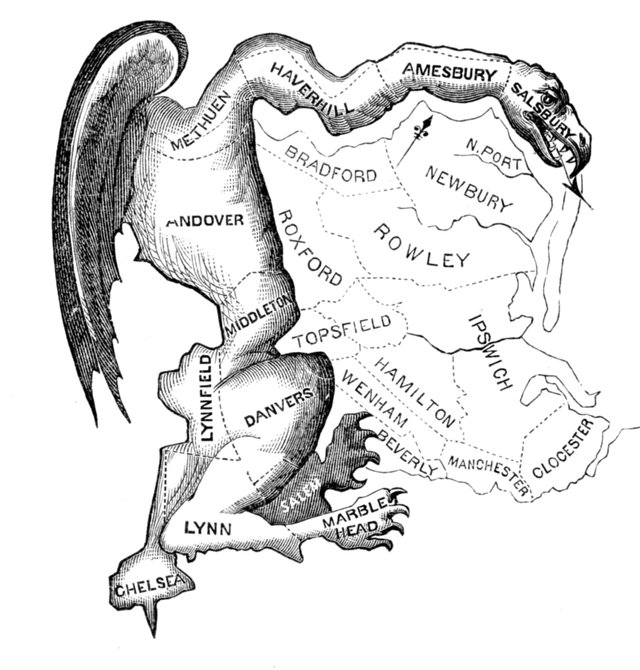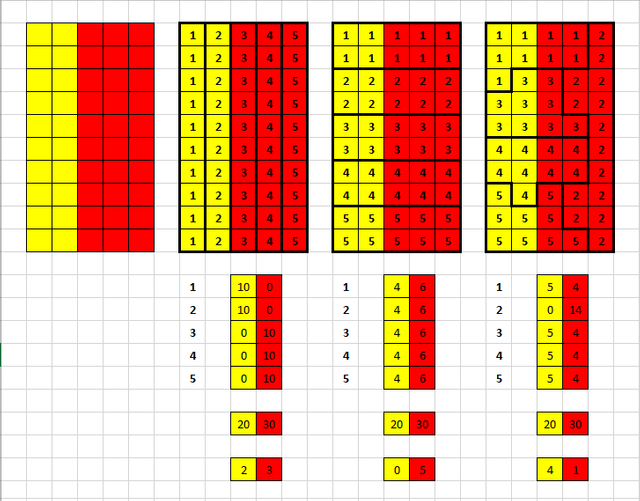The Magazine - Politics & Society - Moot #1 (EN - IT - ES - DE)

 |
|
 |

|
Gerrymandering: a nightmare for democracy |

But it inevitably brings at least one change to the electoral system: the redefinition of the electoral constituencies.
It will probably also involve a change in the electoral law itself, but the redefinition of the colleges is an inevitable consequence.
The devil is always hiding in the details, or, rather, they are the technicalities that distort the best intentions and these are, precisely, delegated to the technicians, often however with a mandate, from the politicians, not really transparent.
One of the most famous techniques, among the experts, is the gerrymandering, a practice in designing electoral colleges, which not many know and which we will try to explain here.
The term gerrymander, from which it derives gerrymandering, comes from an article in the Boston Gazette dated March 26, 1812, and is a portmanteau of the surname of the governor of Massachusetts, Elbridge Gerry and salamander; in that article the exact term used is: Gerry-mander, meaning by this word to describe the salamander of Gerry .
What was the article referring to?
To the fact that the governor Gerry had signed a law that redesigned the boundaries of the circumscriptions in a very particular way with the specific intent to favor the governor's party the Democratic-Republican Party at that time one of the main parties present at the US Congress and Senate.
One of the districts, in fact, was so twisted as to remember the shape of a salamander as usually drawn in mythology, as can be seen from this drawing of the time:

The image represents the district of the state of South Essex for the Senate elections.
We cannot know for sure if this was the first time that this practice has been implemented, surely, since the birth of the term, it has been used countless other times in many countries, in various elections and with multiple functions.
It was not only used to promote a party, but often to favor or disadvantage ethnic, religious, etc. minorities.
A correct design of the electoral colleges must take into account many elements: the electoral system, ethnic, linguistic, religious minorities, social or cultural differences, the topography of the territory, the population, etc.
It is therefore never easy to define the constituencies and, essentially, it is impossible to do so without displeasing anyone.
An imperfect design is therefore the norm when trying to take into account all the variables involved.
In this complicated technicality the gerrymandering is insinuated, often subtly, not always so easily recognizable as in the case that forged its name.
In this example:

we can see how, assuming a majority system with only two parties, the yellows with 40% of the votes and the reds with 60%, appropriately redesigning the colleges, it is possible to obtain completely different results:
| Yellow | Red |
| 2 | 3 |
| 0 | 5 |
| 4 | 1 |
A solution that may seem simple is to define a single national college, a choice actually made by some nations, but only appropriate if there are no ethnic or linguistic minorities concentrated in particular territorial areas; in these cases, a single national college could prevent the representation of some minorities.
Even the diametrically opposed choice, to create very small colleges, consequently increasing the number of delegates (Deputies or Senators), this road also traveled in some countries, can lead to elephantine parliaments that encounter great difficulties in making decisions.
Unfortunately, as often happens, the middle way, with a reasonable number of parliamentarians and a complex definition of the colleges, appears to be the solution, certainly not perfect, but reasonably more democratic.
Knowing the practice of gerrymandering is therefore an antidote to its application, a way to keep your eyes open and exercise that control over the actions of parliaments and governments necessary for a healthy democracy and effective.

En Italia, el país donde vivo, después de varios intentos fallidos, el Parlamento ha decidido reducir el número de diputados y senadores presentes en las dos cámaras, de 630 a 400 para la Cámara de Diputados y de 315 a 200 para el Senado. Este cambio, en sí mismo, no implica una naturaleza mayor o menos representativa de los representantes elegidos y no modifica significativamente el poder de delegación de los votantes.
Pero inevitablemente trae al menos un cambio al sistema electoral: la redefinición de las circunscripciones electorales.
Probablemente también implicará un cambio en la propia ley electoral, pero la redefinición de los colegios es una consecuencia inevitable.
El diablo siempre se esconde en los detalles, o, más bien, son los tecnicismos que distorsionan las mejores intenciones y estos son, precisamente, delegados a los técnicos, a menudo con un mandato de los políticos, no realmente transparentes.
Una de las técnicas más famosas, entre los expertos, es la gerrymandering, una práctica en el diseño de colegios electorales, que no muchos conocen y que trataremos de explicar aquí.
El término gerrymander, del cual deriva gerrymandering, proviene de un artículo en el Boston Gazette fechado el 26 de marzo de 1812, y es una cresta del apellido del entonces gobernador de Massachusetts, Elbridge Gerry y salamandra; en ese artículo, el término exacto utilizado es: Gerry-mander, que significa con esta palabra describir la salamandra de Gerry.
¿A qué se refería el artículo?
Al hecho de que el gobernador Gerry había firmado una ley que rediseñó los límites de las circunscripciones de una manera muy particular con la intención específica de favorecer al partido del gobernador, el Partido Republicano Democrático en ese momento, uno de los principales partidos presentes en el Congreso y el Senado de los Estados Unidos.
Uno de los distritos, de hecho, estaba tan retorcido que recordaba la forma de una salamandra, como suele dibujarse en la mitología, como se puede ver en este dibujo de la época:

La imagen representa el distrito del estado de South Essex para las elecciones al Senado.
No podemos saber con certeza si esta fue la primera vez que se implementó esta práctica, seguramente, desde el nacimiento del término, se ha utilizado innumerables otras veces en muchos países, en varias elecciones y con múltiples funciones.
No solo se usaba para favorecer a un partido, sino a menudo para favorecer o desfavorecer a las minorías étnicas, religiosas, etc.
Un diseño correcto de los colegios electorales debe tener en cuenta muchos elementos: el sistema electoral, las minorías étnicas, lingüísticas, religiosas, las diferencias socioculturales, la orografía del territorio, la población, etc.
Por lo tanto, nunca es fácil definir las circunscripciones y, esencialmente, es imposible hacerlo sin desagradar a nadie.
Por lo tanto, un diseño imperfecto es la norma cuando se trata de tener en cuenta todas las variables involucradas.
En este complicado tecnicismo, el gerrymandering se insinúa, a menudo sutilmente, no siempre tan fácilmente reconocible como en el caso que falsificó su nombre.
En este ejemplo:

Podemos ver cómo, suponiendo un sistema uninominal mayoritario con solo dos partidos, los amarillos con el 40% de los votos y los rojos con el 60%, rediseñando adecuadamente los colegios, es posible obtener resultados completamente diferentes:
| Amarillos | Rojos |
| 2 | 3 |
| 0 | 5 |
| 4 | 1 |
Una solución que puede parecer simple es definir una sola universidad nacional, una elección que realmente toman algunas naciones, pero solo apropiada si no hay minorías étnicas o lingüísticas concentradas en áreas territoriales particulares; En estos casos, una sola universidad nacional podría impedir la representación de algunas minorías.
Incluso la opción diametralmente opuesta, de crear colegios muy pequeños, aumentando en consecuencia el número de delegados (diputados o senadores), este camino también recorrido en algunos países, puede conducir a parlamentos elefantinos que enfrentan grandes dificultades para tomar decisiones.
Desafortunadamente, como suele suceder, el camino intermedio, con un número razonable de parlamentarios y una definición compleja de los colegios, parece ser la solución, ciertamente no perfecta, pero razonablemente más democrática.
Conocer la práctica de gerrymandering es, por lo tanto, un antídoto para su aplicación, una forma de mantener los ojos abiertos y ejercer ese control sobre las acciones de los parlamentos y gobiernos necesarios para una democracia saludable y eficaz.

Porta però con sè, inevitabilmente, almeno una modifica del sistema elettorale: la ridefinizione dei collegi elettorali.
Probabilmente comporterà anche una modifica della legge elettorale stessa, ma la ridefinizione dei collegi è una conseguenza inevitabile.
Il diavolo si nasconde sempre nei dettagli, o, per meglio dire, sono i tecnicismi che stravolgono le migliori intenzioni e questi vengono, appunto, demandati ai tecnici, spesso però con un mandato, da parte dei politici, non proprio trasparente.
Uno dei tecnicismi più famosi, tra gli addetti ai lavori, è il gerrymandering, una pratica nel disegnare i collegi elettorali, che non molti conoscono e che cercheremo qui di spiegare.
Il termine gerrymander, da cui deriva gerrymandering, nasce da un articolo del Boston Gazette del 26 Marzo 1812, ed è una crasi del cognome dell'allora governatore del Massachusetts, Elbridge Gerry e di salamander; in quell'articolo il termine esatto utilizzato è: Gerry-mander, intendendo con questa parola descrivere la salamandra di Gerry.
A cosa si riferiva l'articolo?
Al fatto che il governatore Gerry aveva firmato una legge che ridisegnava i confini delle circoscrizioni in modo alquanto particolare con il preciso intento di favorire alle elezioni il partito del governatore stesso il Democratic-Republican Party ai tempi uno dei principali partiti presenti al Congresso e al Senato degli USA.
Uno dei distretti, infatti, era talmente contorto da ricordare la forma di una salamandra così come disegnata solitamente nella mitologia, come si può vedere da questo disegno dell'epoca:

L'immagine rappresenta il distretto dello stato del South Essex per le elezioni del Senato.
Non possiamo sapere con certezza se questa sia stata la prima volta che questa pratica è stata messa in atto, sicuramente, dalla nascita del termine, è stata usata innumerevoli altre volte in moltissimi paesi, in svariate elezioni e con molteplici funzioni.
Non è stata usata solo per favorire un partito, ma spesso per favorire o sfavorire minoranze etniche, religiose, etc.
Un corretto disegno dei collegi elettorali deve tenere in considerazione moltissimi elementi: il sistema elettorale, le minoranze etniche, linguistiche, religiose, le differenze socio-culturali, l'orografia del territorio, la popolazione, etc.
Non è quindi mai semplice definire i collegi elettorali e, sostanzialmente, è impossibile farlo senza scontentare nessuno.
Un disegno non perfetto è quindi la norma quando si cerca di tenere conto di tutte le variabili in gioco.
In questo complicato tecnicismo si insinua, spesso subdolamente, il gerrymandering, non sempre così facilmente riconoscibile come nel caso che ne ha forgiato il nome.
In questo esempio:

possiamo vedere come, ipotizzando un sistema uninominale maggioritario con soli due partiti, i gialli con il 40% dei voti e i rossi con il 60%, ridisegnando opportunamente i collegi si possano ottenere risultati completamente differenti:
| Gialli | Rossi |
| 2 | 3 |
| 0 | 5 |
| 4 | 1 |
Una soluzione che potrebbe apparire semplice è quella di definire un collegio unico nazionale, scelta effettivamente fatta da alcune nazioni, ma opportuna solo se non sono presenti minoranze etniche o linguistiche concentrate in particolari aree territoriali; in questi casi un collegio unico nazionale potrebbe impedire la rappresentanza di alcune minoranze.
Anche la scelta diametralmente opposta, creare collegi piccolissimi, aumentando conseguentemente il numero di delegati (Deputati o Senatori), strada anche questa percorsa in alcune nazioni, può portare a parlamenti elefantiaci che incontrano grandi difficoltà nel prendere decisioni.
Purtroppo, come spesso accade, la via di mezzo, con un numero ragionevole di parlamentari ed una complessa definizione dei collegi appare la soluzione, certo non perfetta, ma ragionevolmente più democratica.
Conoscere la pratica del gerrymandering è quindi un antidoto alla sua applicazione, un modo per tenere gli occhi aperti ed esercitare quel controllo sulle azioni dei parlamenti e dei governi necessarie per una democrazia sana ed effettiva.

In Italien, dem Land, in dem ich lebe, hat das Parlament nach mehreren gescheiterten Versuchen beschlossen, die Zahl der Abgeordneten und Senatoren in den beiden Kammern von 630 auf 400 für die Abgeordnetenkammer und von 315 auf 200 für den Senat zu verringern. Diese Änderung an sich hat weder einen mehr oder weniger repräsentativen Charakter der gewählten Vertreter zur Folge, noch verändert sie die Befugnis zur Delegation von Wählern erheblich.
Aber es bringt unweigerlich mindestens eine Änderung des Wahlsystems mit sich: die Neudefinition der Wahlkreise.
Es wird wahrscheinlich auch eine Änderung des Wahlgesetzes selbst mit sich bringen, aber die Neudefinition der Kollegien ist eine unvermeidliche Konsequenz.
Der Teufel steckt immer im Detail, oder vielmehr sind es die technischen Details, die die besten Absichten verfälschen, und diese werden genau genommen an die Techniker delegiert, oft jedoch mit einem Auftrag, von den Politikern, die nicht wirklich transparent sind.
Eine der bekanntesten Techniken unter den Experten ist das gerrymandering, eine Praxis zur Gestaltung von Wahlkollegien, die nicht viele kennen und die wir hier zu erklären versuchen werden.
Der Begriff gerrymander, von dem er gerrymandering abgeleitet ist, stammt aus einem Artikel im Boston Gazette vom 26. März 1812 und ist ein Wappen des damaligen Gouverneurs von Massachusetts, Elbridge Gerry und salamander; In diesem Artikel wird der genaue Begriff Gerry-mander verwendet, der mit diesem Wort den Salamander von Gerry beschreibt.
Worauf bezog sich der Artikel?
Zu der Tatsache, dass der Gouverneur Gerry ein Gesetz unterzeichnet hatte, das die Grenzen der Zirkumskriptionen in ganz besonderer Weise umgestaltete, mit der konkreten Absicht, der Gouverneurspartei die zu der Zeit demokratisch-republikanische Partei vorzuziehen auf dem US-Kongress und im Senat anwesende Parteien.
Tatsächlich war einer der Bezirke so verdreht, dass er sich an die Form eines Salamanders erinnerte, wie er normalerweise in der Mythologie gezeichnet wird. Dies geht aus dieser Zeichnung der Zeit hervor:

Das Bild zeigt den Bezirk des Bundesstaates South Essex für die Senatswahlen.
Wir können nicht sicher wissen, ob dies das erste Mal war, dass diese Praxis angewendet wurde, sicherlich wurde sie seit der Geburt des Begriffs unzählige Male in vielen Ländern, bei verschiedenen Wahlen und mit vielfältigen Funktionen angewendet.
Es wurde nicht nur verwendet, um eine Partei zu bevorzugen, sondern oft, um ethnische Minderheiten, Ordensleute usw. zu bevorzugen oder zu benachteiligen.
Eine korrekte Gestaltung der Wahlkollegien muss viele Elemente berücksichtigen: das Wahlsystem, ethnische, sprachliche, religiöse Minderheiten, soziokulturelle Unterschiede, die Orographie des Territoriums, die Bevölkerung usw.
Es ist daher nie einfach, die Wahlkreise zu definieren, und es ist im Grunde unmöglich, dies zu tun, ohne jemandem zu missfallen.
Ein fehlerhaftes Design ist daher die Norm, wenn versucht wird, alle beteiligten Variablen zu berücksichtigen.
In dieser komplizierten Technik wird das gerrymandering unterstellt, oft subtil, nicht immer so leicht erkennbar wie in dem Fall, der seinen Namen gefälscht hat.
In diesem Beispiel:

wir können sehen, wie es möglich ist, völlig unterschiedliche Ergebnisse zu erzielen, wenn man ein Mehrheits-Uninominal-System mit nur zwei Parteien annimmt, die Gelben mit 40% der Stimmen und die Roten mit 60%, die die Colleges angemessen umgestalten:
| Gelb | Rot |
| 2 | 3 |
| 0 | 5 |
| 4 | 1 |
Selbst die diametral entgegengesetzte Entscheidung, sehr kleine Kollegien zu gründen und damit die Anzahl der Delegierten (Abgeordneten oder Senatoren) zu erhöhen, die auch in einigen Ländern befahren werden, kann dazu führen, dass die Parlamente der Elefanten große Entscheidungsschwierigkeiten haben.
Leider scheint, wie so oft, der Mittelweg mit einer angemessenen Anzahl von Parlamentariern und einer komplexen Definition der Kollegien die Lösung zu sein, sicherlich nicht perfekt, aber einigermaßen demokratischer.
Die Praxis des gerrimandering zu kennen, ist daher ein Gegenmittel zu seiner Anwendung, eine Möglichkeit, die Augen offen zu halten und die Kontrolle über die Handlungen von Parlamenten und Regierungen auszuüben, die für eine gesunde Demokratie notwendig sind und effektiv.
edited by @ilnegro

Follow our projects: @steempossible, @themagazine, @storychain and follow the work of our founders @ilnegro and @serialfiller

This post was selected, voted and shared by the discovery-it curation team in collaboration with the C-Squared Curation Collective. You can use the #Discovery-it tag to make your posts easy to find in the eyes of the curator. We also encourage you to vote @c-squared as a witness to support this project.
Congratulations @themagazine! You have completed the following achievement on the Steem blockchain and have been rewarded with new badge(s) :
You can view your badges on your Steem Board and compare to others on the Steem Ranking
If you no longer want to receive notifications, reply to this comment with the word
STOPTo support your work, I also upvoted your post!
Do not miss the last post from @steemitboard:
Vote for @Steemitboard as a witness to get one more award and increased upvotes!